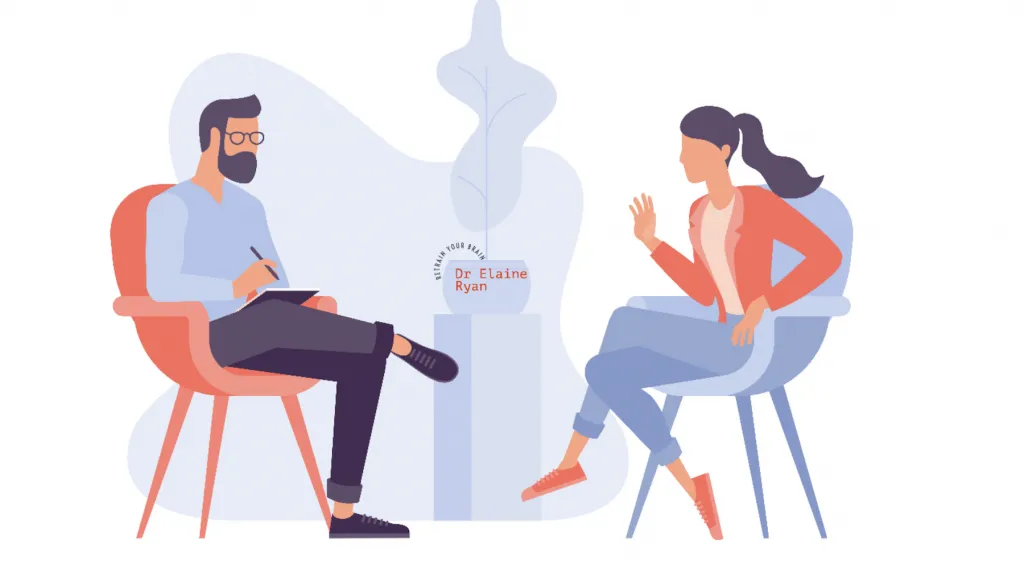We all have experienced psychological triggers at some point, but what are they exactly?
Psychological triggers are stimuli that can cause a stark change of emotion. For example, you might feel calm when you find out you have to take a train, and immediately your chest tightens, and you feel anxious. The thought of the train has triggered feelings of anxiety.
Some common examples of triggers you will be familiar with, and have probably experienced, include.
- Music
- sounds,
- smells.
These triggers can either be positive or negative. For example, the smell of bread from the oven makes me happy. Certain songs bring a smile to my face and remind me of my time at university. Whereas very loud, unexpected sounds can startle and frighten me.
In this article, I shall explain how psychological triggers can change how you feel and even make you avoid things before ending with some ideas on what you can do to manage triggers.

Retrain Your Brain
Online course for anxiety.
Based on Dr Ryan’s private practice
What are psychological triggers?
“Triggers” are situations, sights, sounds, smells, and even people that evoke specific negative responses in us. These responses can be visible, or they can be internal.
Internal triggers
Internal triggers come from within you and can be memories, physical sensations, and emotions. For example, a fast heart rate can remind someone of having a panic attack. Feeling anxious can remind someone of unpleasant experiences in a relationship.
Psychological internal triggers, like all triggers, are unique to the individual and based on their experiences.
External triggers
External triggers can be anything external to the person, such as TV shows and news articles. Someone could enter a shopping centre and get triggered and brought right back to when they had a panic attack in a shop.
How triggers are formed
Psychological triggers are formed when you experience a threatening situation, which causes your body to go into a “fight or flight” response.
This can create a memory where your brain will match up the situation with bad feelings in your body.
This type of memory can protect you should you reencounter the threat. Still, for the person who had a panic attack on a train, this stored memory can cause the person to be triggered each time they try to get on a train, and it even may cause the avoidance of this type of transport.
I want you to play the audio sample below; it’s only a few seconds long.
Did it make you think of Christmas?
I am using this to explain a point. I could make you think of Christmas by getting you to listen to a tiny snatch of music. I could also get you to think of Christmas by talking about a jolly man in a bright red suit, with a big white beard, who keeps saying ‘ho ho ho.’
Memory plays a vital role in anxiety, your mood, and what goes on inside your head and leads me nicely into what I call; The space in between.
Many of us falsely believe that if we have a temper, that is just who we are. Or if we get anxious when making a presentation, that is just who we are. That is just who you are if you do nothing.
Your brain pays more attention to the things you think and regularly feel, growing and strengthening the connections between them, than those things that you do not often do.
It partly explains why you thought of Christmas a few seconds into the music above. The connections in your brain between the music, sizeable jolly man and Christmas have developed and grown over the years. So much so that I could get you to access the thought of Christmas without ever mentioning the word. By getting you to access memory.
You might not fully understand how your memory got jogged to Christmas. Yes, you will know that you associate music with it, but you probably still need to learn what is going on in your brain to make that happen.
This is the space in between you playing the music and thinking of Christmas.
There is also a space in between meeting someone and feeling anxious, giving a talk and worrying about it relentlessly one month beforehand.
It is not just who you are. Understanding the space in between gives you a choice to change.
When I got you to think of Christmas, I triggered your memory in different ways.
- I was using sound: the annoying jingle!
- Imagery: large jolly man in the red suit
- We could also use smell.
If I could use scratch and sniff, you would have gotten the aroma of cinnamon, turkey, oranges and spices. Suppose you think of a turkey just freshly out of the oven. In that case, steam rising and nicely browned and glistening, and that first slice into it, you can see how moist and tender it is, and the smell increases.
I bet you now have too much saliva in your mouth! Do you?
If you do, you are also experiencing how I can change your physiology by getting you to think in specific ways. You will, of course, be pulling from your memory, not mine, but the result is the same.
Your brain can do all of this, even though it is not real, just from how the memory has been stored in your brain.
How to cope with triggers
It’s helpful to identify past triggers and emotions, observe patterns, and plan to address them.
If you are in therapy or even using self-help CBT, you will work with triggers while exploring your thoughts and behaviours.
For example, you might avoid certain things and discover that this is because you fear your anxiety will get triggered, and you might panic.
CBT will help you with this through a process known as exposure therapy.
